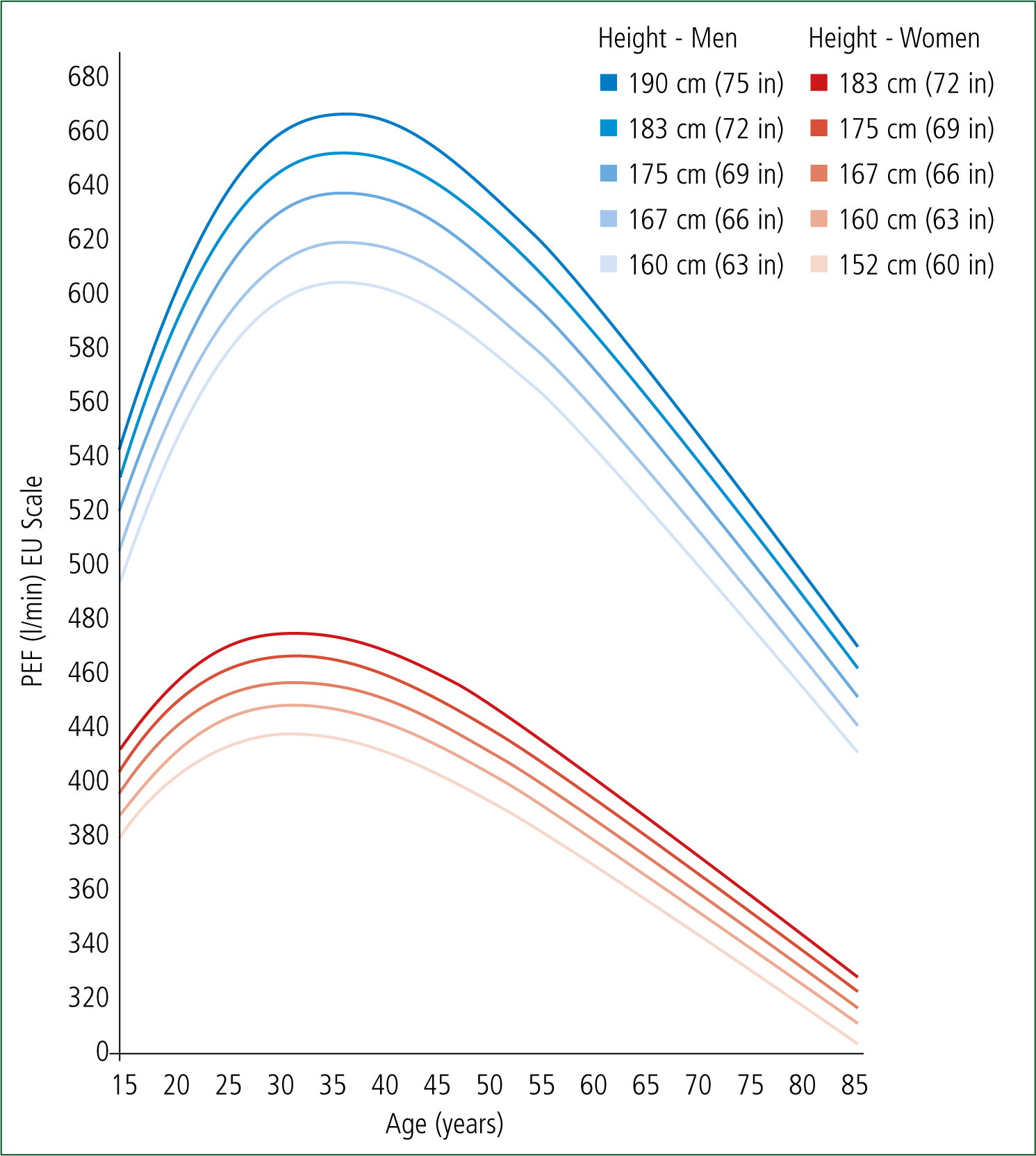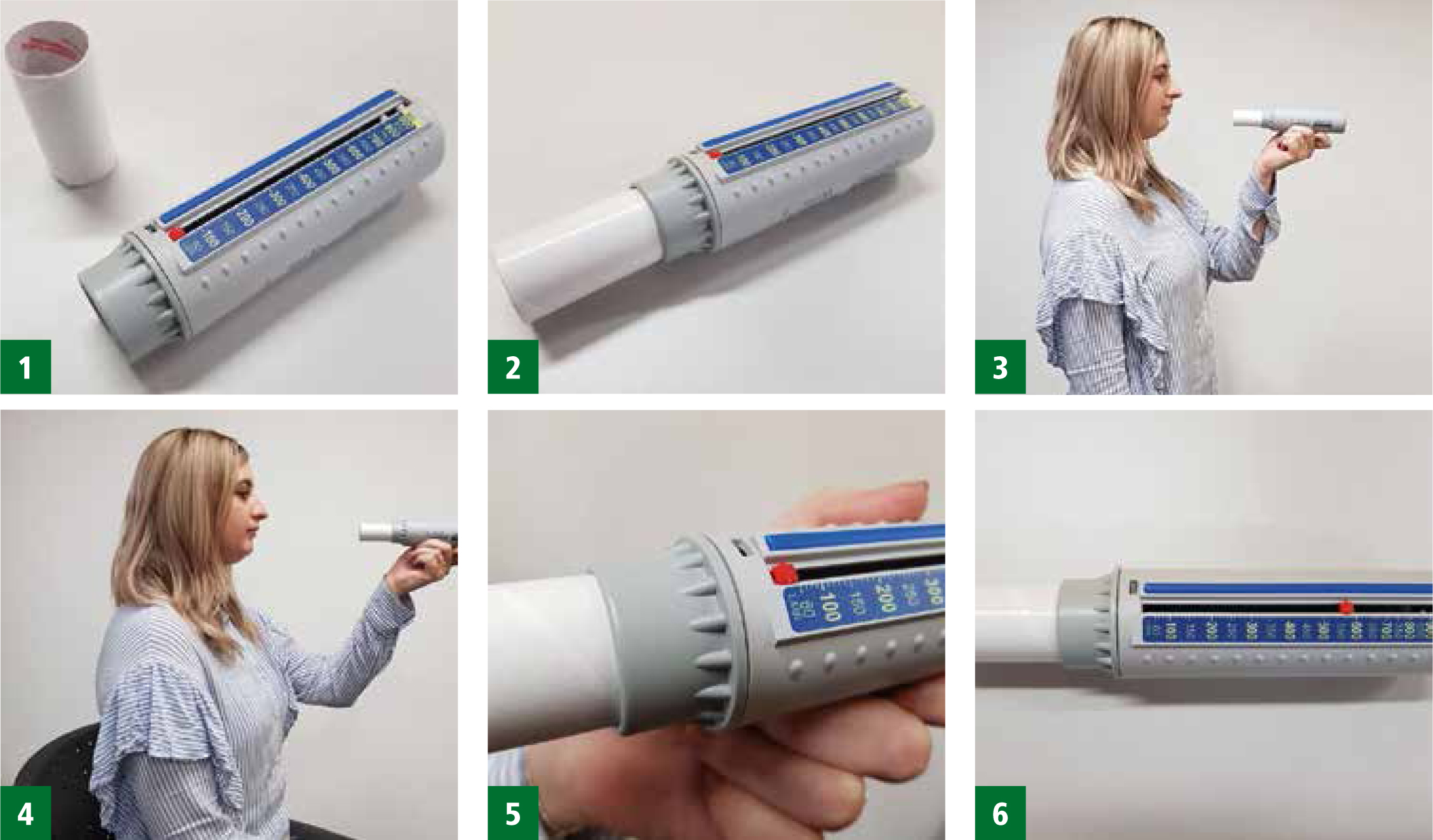
Peak expiratory flow rate (PEFR) is the volume of air forcefully expelled from the lungs in one quick exhalation. It is a reliable indicator of ventilation capacity as well as airflow obstruction (Lane and Rouse, 2011). The normal peak flow value can range from person to person, and is dependent upon factors such as sex, age and height (Thomas and Monaghan, 2017). PEFR is typically higher in males than females and higher in taller patients. After expected increases through childhood and adolescence, PEFR decreases with age from 30–40 years onwards Figure 1) (Boezen et al, 1994; Tortora and Derrickson, 2009).

Asthma is the most common condition that affects peak flow (Quanjer et al, 1997). However, other conditions, such as chronic obstructive pulmonary disease (COPD), that cause airway obstruction can also affect PEFR (Talley and O'Connor, 2014; Pilberry and Lethbridge, 2016).
Asthma is a chronic condition characterised by exacerbations of airway hypersensitivity, bronchoconstriction, mucus secretion and inflammation of the lower airways (Grossman and Porth, 2014). An exacerbation of asthma caused by a trigger, e.g. cold air, causes the lower airways to narrow, trapping air, and resulting in a struggle to exhale. This can lead to a ventilation/perfusion mismatch, hypoxia, hypercapnia and acid-base imbalances—each of which can cause potentially life-threatening complications if not treated promptly (van Wamel and Procter, 2010).
PEFR is a simple, easy, and essential diagnostic measurement used to assess asthma severity (Booker, 2009; Talley and O'Connor, 2014; Thomas and Monaghan, 2017). Peak flow is also an important measure of the effectiveness of treatment with bronchodilator therapy (Frew and Holgate, 2009). Peak flow meters (EU/EN ISO standard) are handheld devices used to measure PEFR in the ambulatory setting.
Indications for peak flow
In the pre-hospital setting, peak flow can be used to assess the severity of an asthma exacerbation (Reddel, 2006; Booker, 2007; 2009). It is also indicated to assess the effects of therapy post nebulisation (Booker, 2007; Frew and Holgate, 2009).
Contraindications
Patients who are severely short of breath and unable to achieve full inspiration may not tolerate a peak flow, and in situations where the patient is in severe respiratory distress, attempting a peak flow reading may quicken the deterioration of their breathing (Quanjer et al, 1997; Joint Royal Colleges Ambulance Liaison Committee (JRCALC), 2016).
Patients diagnosed with asthma may already have a peak flow meter and undertake daily readings, logging these on their own personalised charts (JRCALC, 2017). Peak flow readings can change throughout the day; therefore patients are advised to record their readings both morning and evening (Asthma UK, 2017). It is important to ascertain an individual's normal and best PEFR values, and compare current readings along with the normal values chart (Figure 1).
Performing the procedure
Several steps outlining how to obtain an accurate PEFR reading according to best practice (Figure 2) are as follows:

If the patient is too breathless to perform a PEFR, this should be noted as being unable to obtain a reading. This in itself can indicate the severity of the patient's shortness of breath.
Clinical implications and patient management
During an exacerbation of asthma, air becomes trapped as a result of bronchoconstriction and inflammation and therefore limits the volume of air exhaled during each breath. This can present with differing levels of severity, which can affect peak flow values (Table 1). See the below example of best PEFR practice:
| Mild/moderate | Acute severe | Life-threatening |
|---|---|---|
| PEFR >50–75% best or predicted | Adults: |
Adults: |
‘A 25-year-old female asthmatic patient presents severely short of breath and, after initial assessment, has a PEFR of 200 litres/minute. She does not know her normal values. After comparing with the normal values chart, this presents as an acute severe exacerbation of asthma. After appropriate treatment with nebulised bronchodilators and other medications in accordance with national guidelines, the patient's breathing improves. A second PEFR is taken with a recording of 340 litres/minute. This shows an increase in PEFR translating to an improvement of the patient's airflow and therefore effective clinical management.’
Evaluation
If possible, a peak flow rate should be obtained both prior to nebuliser therapy and following nebulisation, with a beta-2 adrenoreceptor agonist such as Salbutamol (JRCALC, 2017). Pre- and post nebuliser readings help to ascertain the severity of the exacerbation, the reversibility, or whether it is progressive COPD (Lane and Rouse, 2011).
A reduction in the patient's PEFR compared to recent results or best predicted values can indicate a red flag and immediate treatment of the airflow obstruction is required (Dougherty and Lister, 2011). Nebulisation of bronchodilator therapy should be commenced in line with national guidelines (JRCALC, 2016) with oxygen saturations aimed at 94–98% (British Thoracic Society (BTS) and Scottish Intercollegiate Guidelines Network (SIGN), 2016).
Van Wamel and Procter (2010) found that many paramedics do not perform PEFR on a regular basis with asthma patients. Some clinicians state that if they can see the patient is clinically unwell and in requirement of emergency treatment, no peak flow is required (van Wamel and Procter, 2010). However, van Wamel and Procter (2010) highlight that severity of asthma is based on outcome, not initial presentation and that severity may be being underestimated in the pre-hospital environment. Harvey et al (2003) highlight that the inadequate assessment of the severity of asthma can contribute to asthma deaths. Early PEFR after nebulisation is a powerful indicator of the severity of asthma. Improvement of PEFR following bronchodilator therapy can indicate a positive outcome measure and reduction in airway obstruction. This can also help differentiate between poorly reversible conditions such as COPD (Thomas and Monaghan, 2017).
Peak flow measurement is therefore highlighted as best practice for the assessment and management of patients with asthma in the acute setting.

